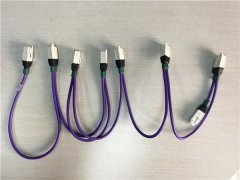When choosing a wire harness processing plant, customers attach great importance to every process of wire harness processing. Because the details and the integration process are directly related to the quality of the wiring harness. Therefore, for an excellent wire harness manufacturer, wire harness processing should be comprehensive and meticulous, and strict management should be used to ensure good quality. As a leading professional manufacturer of high-end composite wire harness products, the ten major processes that wire harness manufacturers must follow when processing and producing are coming. Look at the following processes:
1. Acceptance of receiving materials: Use ROHS instruments for environmental testing to test whether all feeder bundles comply with ROHS standards. Equipment required: OHS test equipment. Processing requirements: The feed should not contain harmful substances such as lead (Pb), mercury (Hg), cadmium (Cd), brominated biphenyls (PBB), polybrominated diphenyl ethers (PBDE), etc.

2. Wire feeder: Put the required processing line into the transmission line rack. Equipment needed: wire feeder. Process requirements: Be careful not to scratch the surface of the wire.
3. Wire feeding: The wire should be fixed on the wire feeding machine. Equipment needed: wire feeder. Process requirements: Be careful not to scratch the surface of the wire.
4. Thread cutting: cut the length of the thread with a wire cutter. Equipment needed: computer cutting machine. Processing requirements: Do not cut the surface of the wire; do not cut the copper wire; the stripping length error should not exceed (+1mm).

5. Steel wire stripping: According to SOP requirements, remove the corresponding length of heat insulation sleeve. Equipment needed: Pneumatic peeling machine. Process requirements: It is not allowed to compress the surface, and the stripping error is not allowed to exceed +1mm.
6. Torsion: The conductor is completed and twisted at the joint. Equipment requirements: twisting machine. Process requirements: There should be no scratches or scratches on the surface of the wire. The copper wire must be tightened and cannot be loosened.
7. Riveted terminal: the conductor and plug terminal of the riveted joint. Equipment needed: terminal machine. Process requirements: The terminal is not allowed to deform, and must meet the requirements of tension, riveting height and width.
8. Product assembly: Assemble plastic plugs. Equipment requirements: electric screwdriver. Process requirements: Screws are not allowed to expose the surface of the rubber shell, and the torque must meet the requirements of the product.

9. Conductivity test: instrument wiring test. Required equipment: continuity tester. Process requirements: no short circuit, open circuit, incorrect wiring, poor contact, and poor insulation.
10. Packaging and sealing: Use plastic bags to package the wire harness products and put them in a carton. Equipment needed: sealing machine and baler. Process requirements: The seal must be smooth, and the packaging tape must be packed in a carton without falling off.
Harness manufacturers must pay attention to the process and strictly control the details. Only in this way can the quality of the product be guaranteed.
